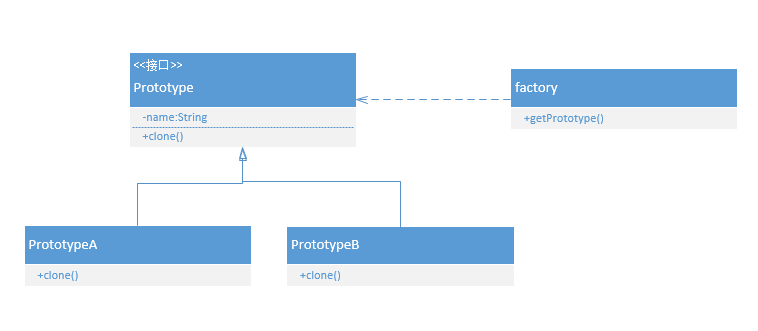原型模式属于创建型设计模式
推荐访问我的个人网站,排版更好看:https://chenmingyu.top/design-phototype/
原型模式
原型模式通过克隆一个已经存在的对象实例来返回新的实例,而不是通过new去创建对象,多用于创建复杂的或者耗时的实例,因为这种情况下,复制一个已经存在的实例使程序运行更高效;
java中复制对象是通过重写clone()实现的,原型类需要实现Cloneable接口,否则报CloneNotSupportedException异常
类图

抽象原型角色:Prototype,可以为接口或者抽象类,实现了
Cloneable接口,重写了clone()方法,子类只需实现或集成即可拥有克隆功能具体原型角色:PrototypeA,PrototypeB,实现/集成了Prototype接口的类,拥有克隆方法
工厂模式:原型模式常和工厂模式一起使用,通过 clone 的方法创建一个对象,然后由工厂方法提供给调用者
实现
以笔为例子,结合工厂模式讲解如何使用原型模式,涉及的类:Pen(抽象类),Pencil(铅笔),CarbonPen(碳素笔),PenFactory(工厂方法)
Pen
抽象类,抽象原型角色,实现了Cloneable接口,重写了clone()方法
/**
* @author: chenmingyu
* @date: 2019/2/28 09:54
* @description: 抽象原型角色
*/@Datapublic abstract class Pen implements Cloneable{ private String name; public Pen(String name) { this.name = name;
} @Override
protected Object clone() throws CloneNotSupportedException { return super.clone();
}
}Pencil
继承了Pen,具体原型角色
/**
* @author: chenmingyu
* @date: 2019/2/28 11:27
* @description: 铅笔
*/public class Pencil extends Pen{ public Pencil(String name) { super(name);
}
}CarbonPen
继承了Pen,具体原型角色
/**
* @author: chenmingyu
* @date: 2019/2/28 11:29
* @description: 碳素笔
*/public class CarbonPen extends Pen{ public CarbonPen(String name) { super(name);
}
}PenFactory
简单工厂实现
/**
* @author: chenmingyu
* @date: 2019/2/28 11:32
* @description: 笔生产工厂
*/public class PenFactory { /**
* 原型类容器
*/
private static Map<String, Pen> penMap = new Hashtable<>(); /**
* 初始化
*/
public static void init() {
Pen carbonPen = new CarbonPen("碳素笔");
penMap.put(CarbonPen.class.getName(),carbonPen);
Pen pencil = new Pencil("铅笔");
penMap.put(Pencil.class.getName(),pencil);
} /**
* 通过复制获取实例
* @param className
* @return
* @throws CloneNotSupportedException
*/
public static Pen getPen(Class className) throws CloneNotSupportedException{
Pen cachedShape = penMap.get(className.getName()); return (Pen) cachedShape.clone();
}
}调用
public static void main(String[] args){
PenFactory.init();
IntStream.range(0,2).forEach(i->{ try {
System.out.println(PenFactory.getPen(CarbonPen.class).getClass());
System.out.println(PenFactory.getPen(Pencil.class).getClass());
System.out.println(" ... ");
}catch (CloneNotSupportedException e){
e.printStackTrace();
}
});
}输出
class com.example.design.prototype.CarbonPenclass com.example.design.prototype.Pencil ... class com.example.design.prototype.CarbonPenclass com.example.design.prototype.Pencil ...
浅拷贝和深拷贝
浅拷贝:将一个对象复制后,基本类型会被重新创建,引用类型的对象会把引用拷贝过去,实际上还是指向的同一个对象
深拷贝:将一个对象复制后,基本类型和引用类型的对象都会被重新创建
浅拷贝
举个例子
/**
* @author: chenmingyu
* @date: 2019/2/28 14:53
* @description: 克隆
*/@Datapublic class Clone implements Cloneable{ private CloneA CloneA; public Clone() { this.CloneA = new CloneA();
} @Override
protected Clone clone() throws CloneNotSupportedException { return (Clone) super.clone();
} class CloneA{
}
}测试
public static void main(String[] args) throws CloneNotSupportedException{
Clone clone = new Clone();
Clone clone1 = clone.clone();
System.out.println(clone == clone1);
System.out.println(clone.getCloneA() == clone1.getCloneA());
}输出
false true
所以clone()方法是执行的浅拷贝,这个需要在写代码的时候注意一下,浅拷贝是否可以满足需求
深拷贝
深拷贝的实现方案主要有两种
引用类型也使用clone(),进行clone的时候,对引用类型在调用一次clone()方法
使用序列化,将对象序列化后在反序列化回来,得到新的对象实例
使用序列化实现以下
/**
* @author: chenmingyu
* @date: 2019/2/28 14:53
* @description: 浅克隆
*/@Datapublic class Clone implements Cloneable ,Serializable { private CloneA CloneA; public Clone() { this.CloneA = new CloneA();
} @Override
protected Clone clone() throws CloneNotSupportedException { return (Clone) super.clone();
} /**
* 深拷贝
* @return
* @throws CloneNotSupportedException
*/
protected Clone deepClone() throws CloneNotSupportedException {
Clone clone = null; try{
ByteArrayOutputStream baos=new ByteArrayOutputStream();
ObjectOutputStream oos=new ObjectOutputStream(baos);
oos.writeObject(this);
oos.close();
ByteArrayInputStream bais=new ByteArrayInputStream(baos.toByteArray());
ObjectInputStream ois=new ObjectInputStream(bais); //生成新的对象实例
clone=(Clone)ois.readObject();
ois.close();
}catch (Exception e){
e.printStackTrace();
} return clone;
} class CloneA implements Serializable{
}
}测试
public static void main(String[] args) throws CloneNotSupportedException{
Clone clone = new Clone();
Clone clone1 = clone.deepClone();
System.out.println(clone == clone1);
System.out.println(clone.getCloneA() == clone1.getCloneA());
}输出
false false
在使用原型模式的时候一定要理解什么是浅拷贝和深拷贝,才可以放心的使用原型模式,并且一般都会和工厂模式一起使用
作者:叫我明羽

 随时随地看视频
随时随地看视频




